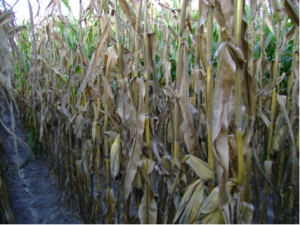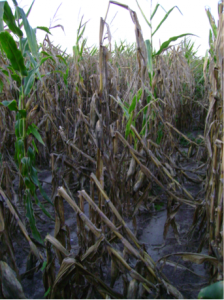
Fact Sheets And Publications

Stalk Rots on Corn
Stalk rots are one of the most significant set of diseases on corn. These diseases are insidious, and often growers are unaware of their effects until harvest. Low levels of stalk rot occur in nearly every corn field in Delaware, and severity and incidence varies from year to year. Stalk rots can cause breakage and lodging of stalks and plant death. In many cases the internal tissues of the stalk, or pith is compromised. This publication will discuss general symptoms of these diseases, identification of stalk rotting pathogens, factors that increase stalk rots, management, and scouting recommendations.

Disease Symptoms
Initial symptoms of stalk rots are noticed by premature wilting and ear drop (Figure 1). As the disease progresses stalks senesce rapidly and turn brown to gray.
Figure 1. Symptoms of stalk rots in corn include premature wilt and ear drop.
Stalk rot pathogens decay the central pith, which weakens the stalk. One can envision a healthy stalk being a solid rod of plant tissue. A rotted stalk is no more than a tube with decaying pith loosely packed inside. Thus, corn suffering from stalk rot will easily lodge, or bend when exposed to windy conditions common in Delaware (Figure 2). In addition, plants suffering from stalk rot have rotted roots, which also favors lodging.
Figure 2. Decreased stalk strength resulting from the activity of stalk rotting pathogens causes lodging.
Identification of Stalk Rots
There are a few common stalk rots in Delaware. Characteristics of these stalk rots are listed below (Table 1).
Table 1. Stalk rot pathogens commonly occurring in Delaware.
| Disease | Organism | External Symptoms | Internal Symptoms |
|---|---|---|---|
| Anthracnose stalk rot | Colletotrichum graminicola | Black shiny areas covering outer stalk. Typically located near base of plant. | Lower nodes contain macerated pith. Tan to brown discoloration. |
| Diplodia stalk rot | Stenocarpella maydis | Small black structures embedded within lower stalk rind. | Lower nodes contain macerated pith. Tan to brown discoloration. |
| Charcoal rot | Macrophomina phaseolina | Black pin head or smaller structures peppered throughout macerated pith. | |
| Gibberella stalk rot | Fusarium graminearum | Small, round, bluish/black structrures attached superfiially to nodes. | Lower nodes contain macerated pith. Pink/red discoloration. |
| Fusarium stalk rot | Fusarium moniliforme and others | Lower nodes contain macerated pith. Pink/purple discoloration. | |
| Bacterial stalk rot | Erwinia chrysanthemi | Fetid, foul odor. Watersoaking at internodes. | Slimy rot of internal tissue |

Factors that Increase Stalk Rots
Carbohydrate stress in corn can be caused by either a) limits to photosynthesis or b) overcommitment of carbohydrate resources to the ear. The following are generalizations. For more detailed information refer to agronomy texts or primary literature.
Photosynthetic limitation can be caused by numerous factors. The most important factors impacting stalk rots in corn are foliar diseases, insect damage, cloud cover, high plant density, and nutrient and water deficiencies. Disease and insect damage reduce the amount of photosynthetic area, thereby reducing the overall carbon budget. As levels of damage to foliage by pathogens and pests increase, so too does the amount of stalk rot. Cloud cover and high planting density reduce the amount of light accessible to foliage and therefore photosynthetic rate. High planting densities also can limit access to water and nutrients, which reduce photosynthetic rate through other mechanisms.
Fertility
Limited access to nutrients critical to photosynthesis can cause carbohydrate stress and increase stalk rots. Although there is variability in terms of specific nutrients and diseases, in general, stalk rots increase when nutrients are lost during the growing season. Conversely, over fertilization can cause excessively lush growth. Lush growth is often structurally weak and easily invaded by fungi.
Water
Limitations to water impact the amount of gaseous carbon that moves to the foliage from the atmosphere. Plants contain tiny openings in the foliage and stems that allow gas exchange. When water is plentiful, these openings open. When water is deficient, these openings close, which limits the amount of carbon that enters the plant leaf and therefore the amount of carbohydrates available for grain fill, plant defense, etc. Therefore, any factor that limits the ability of the plant to access water may ultimately predispose the plant to stalk rot. Excessively wet conditions can leach nitrogen from the soil and stress roots, facilitating fungal infection.
Hybrid Genetics
Hybrids differ in their susceptibility to stalk rots. In general, hybrids with low ratings of stalk strength or those that produce exceptionally large ears tend to be more prone to stalk rots than those with strong stalks and smaller ears. Hybrids also can differ in their water and nutrient use profiles, which as mentioned previously, impact the carbon budget of the plant.
Management
Management of stalk rots should include the use of: 1) hybrids with resistance to stalk rot pathogens and/or high ratings of stalk strength and stay green characteristics; 2) a balanced fertility program based on the environment, population, and hybrid; 3) programs to control foliar diseases and insects; 4) irrigation to avoid drought stress.
Scouting
Scouting is crucial for minimizing losses caused by stalk rots. Fields can be scouted for stalk rot before harvest by scouting 1 site for every acre of the field. At each site pinch the base of ten plants to assess stalk integrity. Plants that can be pinched easily between the thumb and index finger are likely suffering from stalk rot. Alternatively, push plants 30-40 degrees from vertical. Plants suffering from stalk rot will fall over easily. If more than 10-15% of tested plants in a field show lodging potential schedule that field for early harvest.
Date Published: 02/2014
Author(s): Nathan Kleczewski Ph.D.
Extension Plant Pathologist
UD Cooperative Extension
This institution is an equal opportunity provider.
In accordance with Federal law and U.S. Department of Agriculture policy, Cooperative Extension is prohibited from discriminating on the basis of race, color, national origin, sex, age, or disability.
